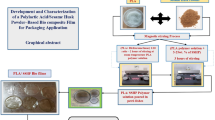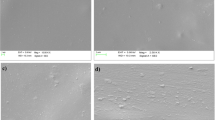Abstract
With an intention to replace the synthetic non-biodegradable films in packaging applications, the polyvinyl alcohol (PVA) blended with green banana peel filler (GBPF), the biodegradable films were prepared by solution casting method with varying the concentrations of GBPF (5–25 wt%) in PVA matrix. The bio films were characterized by Fourier-transform infrared spectroscopy (FTIR), X-ray diffraction (XRD), thermo gravimetric analysis, transmissibility, FESEM, tensile test, film solubility and water absorption, water vapour transmission (WVT), soil burial test. Based on results obtained, the changes evidenced in the FTIR spectrum of this PVA/GBPF biofilms suggest that strong hydrogen bonding is taking place due to interfacial exchanges of GBPF in PVA matrix. The XRD results showed that crystallinity of bio films are greater than PVA. Thermo gravimetric analyses predicted that PVA/GBPF bio films are thermally stable up to 300 °C. The light is 45% for transmittance in the visible light region for the PVA/GBPF (25 wt%) bio film. The FESEM micrographs of biofilms palpable that formation of good physical interaction and compatibility between polymer matrix and GBPF up to 20 wt% of GBPF in PVA Matrix. FESEM results also confirmed that higher loading of GBPF (25 wt%) in PVA matrix, observed voids and agglomerations in film surface. The PVA/GBPF bio films with 20% of GBPF gave the highest tensile strength and young’s modulus 44.5 MPa and 66.7 GPA respectively compared to other samples. The elongation at break decreases with increases the GBPF in PVA Matrix up to 20 wt%.The slight decrease in mechanical properties perceived due to higher loading of GBPF (25 wt%) with PVA matrix. The solubility, water absorption and WVT of the PVA/GBPF bio films increased upon increasing the GBPF content. The biodegradation test results discovered that he highest weight loss at 42.3% (25 wt% of GBPF) probably due to the hydrophilic nature of GBPF in PVA matrix. On the whole, the present investigation confirmed that the PVA/GBPF bio films potential for possible utilization in active packaging applications attributable to its better mechanical, thermal, optical, water absorption and biodegradation properties.











Similar content being viewed by others
References
Sadanand V, Rajini N, Rajulu AV, Satyanarayana B (2016) Preparation of cellulose composites with in situ generated copper nanoparticles using leaf extract and their properties. Carbohyd Polym 150:32–39
Tian H, Wang K, Liu D, Yan J, Xiang A, Rajulu AV (2017) Enhanced mechanical and thermal properties of poly (vinyl alcohol)/corn starch blends by nanoclay intercalation. Int J Biol Macromol 101:314–320
Basu A, Kundu S, Sana S, Halder A, Abdullah MF, Datta S, Mukherjee A (2017) Edible nano-bio-composite film cargo device for food packaging applications. Food Packag Shelf Life 11:98–105
Khan A, Khan AAP, Asiri AM, Gupta V, Rathore M (2016) Preparation, properties and applications of organic–inorganic hybrid nanocomposite poly (aniline-co-o-toluidine) tungstomolybdate. J Mol Liq 216:646–653
Wróblewska-Krepsztul J, Rydzkowski T, Borowski G, Szczypiński M, Klepka T, Thakur VK (2018) Recent progress in biodegradable polymers and nanocomposite-based packaging materials for sustainable environment. Int J Polym Anal Charact 23(4):383–395
Neto JSS, Lima RAA, Cavalcanti DKK, Souza JPB, Aguiar RAA, Banea MD (2019) Effect of chemical treatment on the thermal properties of hybrid natural fiber-reinforced composites. J Appl Polym Sci 136(10):47154
Cano AI, Cháfer M, Chiralt A, González-Martínez C (2015) Physical and microstructural properties of biodegradable films based on pea starch and PVA. J Food Eng 167:59–64
Pan L, Pei X, He R, Wan Q, Wang J (2012) Multiwall carbon nanotubes/polycaprolactone composites for bone tissue engineering application. Colloids Surf B 93:226–234
Zhang Y, Yu C, Chu PK, Lv F, Zhang C, Ji J, Wang H (2012) Mechanical and thermal properties of basalt fiber reinforced poly (butylene succinate) composites. Mater Chem Phys 133(2–3):845–849
Khan A, Rangappa SM, Jawaid M, Siengchin S, Asiri AM (eds) (2020) Hybrid fiber composites: materials, manufacturing, process engineering. Wiley, Hoboken
Vehapi M, Yilmaz A, Özçimen D (2020) Fabrication of oregano-olive oil loaded PVA/chitosan nanoparticles via electrospraying method. J Nat Fibers. https://doi.org/10.1080/15440478.2020.1774463
Nayak S, Khuntia SK, Mohanty SD, Mohapatra J (2020) Investigation and fabrication of thermo-mechanical properties of Ceiba Pentandra bark fiber/poly (vinyl) alcohol composites for automobile dash board and door panel applications. J Nat Fibers. https://doi.org/10.1080/15440478.2020.1745124
SenthilMuthu Kumar T, Rajini N, Jawaid M, VaradaRajulu A, WinowlinJappes JT (2018) Preparation and properties of cellulose/tamarind nut powder green composites: (green composite using agricultural waste reinforcement). J Nat Fibers 15(1):11–20
Xia G, Reddy KO, Maheswari CU, Jayaramudu J, Zhang J, Zhang J, Rajulu AV (2015) Preparation and properties of biodegradable spent tea leaf powder/poly (propylene carbonate) composite films. Int J Polym Anal Charact 20(4):377–387
Rathinavel S, Saravanakumar SS (2020) Development and analysis of poly vinyl alcohol/orange peel powder biocomposite films. J Nat Fibers. https://doi.org/10.1080/15440478.2019.1711285
Balavairavan B, Saravanakumar SS, Manikandan KM (2020) Physicochemical and structural properties of green bio films from poly (vinyl alcohol)/nano coconut shell filler. J Nat Fibers. https://doi.org/10.1080/15440478.2020.1723778
Manikandan KM, Yelilarasi A, Senthamaraikannan P, Saravanakumar SS, Khan A, Asiri AM (2019) A green-nanocomposite film based on poly (vinyl alcohol)/Eleusinecoracana: structural, thermal, and morphological properties. Int J Polym Anal Charact 24(3):257–265
Eltayeb NE, Khan A (2020) Preparation and properties of newly synthesized polyaniline@ graphene oxide/Ag nanocomposite for highly selective sensor application. J Mater Res Technol 9(5):10459–10467
Vu HT, Scarlett CJ, Vuong QV (2017) Effects of drying conditions on physicochemical and antioxidant properties of banana (Musa cavendish) peels. Drying Technol 35(9):1141–1151
Astuti P, Erprihana AA (2014) Antimicrobial edible film from banana peels as food packaging. Am J Oil Chem Technol 2(2):66–70
González-Montelongo R, Lobo MG, González M (2010) Antioxidant activity in banana peel extracts: testing extraction conditions and related bioactive compounds. Food Chem 119(3):1030–1039
Tibolla H, Pelissari FM, Martins JT, Vicente AA, Menegalli FC (2018) Cellulose nanofibers produced from banana peel by chemical and mechanical treatments: characterization and cytotoxicity assessment. Food Hydrocoll 75:192–201
Rattanavichai W, Cheng W, Chang CC (2017) Simplified processing method of banana (Musa acuminata) peels possess the improvement in immunological responses of Macrobrachium rosenbergii. Aquac Res 48(10):5202–5213
Xue M, Lu W, Chen C, Tan Y, Li B, Zhang C (2019) Optimized synthesis of banana peel derived porous carbon and its application in lithium sulfur batteries. Mater Res Bull 112:269–280
Emaga TH, Andrianaivo RH, Wathelet B, Tchango JT, Paquot M (2007) Effects of the stage of maturation and varieties on the chemical composition of banana and plantain peels. Food Chem 103(2):590–600
Kong FB, He QL, Peng W, Nie SB, Dong X, Yang JN (2020) Eco-friendly flame retardant poly (lactic acid) composites based on banana peel powders and phytic acid: flame retardancy and thermal property. J Polym Res 27(8):1–12
Khawas P, Das AJ, Deka SC (2016) Production of renewable cellulose nanopaper from culinary banana (Musa ABB) peel and its characterization. Ind Crops Prod 86:102–112
Hassan MM (2018) Enhanced antimicrobial activity and reduced water absorption of chitosan films graft copolymerized with poly (acryloyloxy) ethyltrimethylammonium chloride. Int J Biol Macromol 118:1685–1695
Aguirre A, Borneo R, León AE (2011) Properties of triticale flour protein based films. LWT-Food Sci Technol 44(9):1853–1858
Laxmeshwar SS, Madhu Kumar DJ, Viveka S, Nagaraja GK (2012) Preparation and properties of biodegradable film composites using modified cellulose fibre-reinforced with PVA. ISRN Polym Sci. https://doi.org/10.5402/2012/154314
Kamel NA, Abd El-messieh SL, Saleh NM (2017) Chitosan/banana peel powder nanocomposites for wound dressing application: preparation and characterization. Mater Sci Eng C 72:543–550
Suki FM, Ismail H, Hamid ZA (2014) Preparation and properties of polyvinyl alcohol/banana frond flour biodegradable film. Prog Rubber Plast Recycl Technol 30(2):103–114
Zhong OX, Ismail H, Abdul Aziz NA, Abu Bakar A (2011) Preparation and properties of biodegradable polymer film based on polyvinyl alcohol and tropical fruit waste flour. Polym Plast Technol Eng 50(7):705–711
Wang H, Fang P, Chen Z, Wang S (2007) Synthesis and characterization of CdS/PVA nanocomposite films. Appl Surf Sci 253(20):8495–8499
Tahir MH, Zhao Z, Ren J, Rasool T, Naqvi SR (2019) Thermo-kinetics and gaseous product analysis of banana peel pyrolysis for its bioenergy potential. Biomass Bioenerg 122:193–201
Peng Z, Kong LX (2007) A thermal degradation mechanism of polyvinyl alcohol/silica nanocomposites. Polym Degrad Stab 92(6):1061–1071
Vu HT, Scarlett CJ, Vuong QV (2018) Phenolic compounds within banana peel and their potential uses: a review. J Funct Foods 40:238–248
Silva VDM, Macedo MCC, Rodrigues CG, dos Santos AN, Loyola ACDF, Fante CA (2020) Biodegradable edible films of ripe banana peel and starch enriched with extract of Eriobotrya japonica leaves. Food Biosci 38:100750
Pelissari FM, Andrade-Mahecha MM, Amaral Sobral PJ, Menegalli FC (2013) Comparative study on the properties of flour and starch films of plantain bananas (Musa paradisiaca). Food Hydrocoll 30(2):681–690
Vorobyeva OV, Andrusenko SF, Volosova EV, Avanesyan SS, Ivanova AM, Kadanova AA (2011) Modification of natural polymers for synthesis of biodegradable materials. Chem Sustain Dev 19(2):131–134
El Bourakadi K, Merghoub N, Fardioui M, Mekhzoum MEM, Kadmiri IM, Essassi EM, Bouhfid R (2019) Chitosan/polyvinyl alcohol/thiabendazoluim-montmorillonite bio-nanocomposite films: mechanical, morphological and antimicrobial properties. Compos B 172:103–110
Rajini N, Alavudeen A, Siengchin S, Rajulu V, Ayrilmis N (2019) Development and analysis of completely biodegradable cellulose/banana peel powder composite films. J Nat Fibers. https://doi.org/10.1080/15440478.2019.1612811
Guo G, Xiang A, Tian H (2018) Thermal and mechanical properties of eco-friendly poly (vinyl alcohol) films with surface treated bagasse fibers. J Polym Environ 26(9):3949–3956
Perumal AB, Sellamuthu PS, Nambiar RB, Sadiku ER (2018) Development of polyvinyl alcohol/chitosan bio-nanocomposite films reinforced with cellulose nanocrystals isolated from rice straw. Appl Surf Sci 449:591–602
Asad M, Saba N, Asiri AM, Jawaid M, Indarti E, Wanrosli WD (2018) Preparation and characterization of nanocomposite films from oil palm pulp nanocellulose/poly (Vinyl alcohol) by casting method. Carbohyd Polym 191:103–111
Orsuwan A, Sothornvit R (2015) Effect of miniemulsion cross-linking and ultrasonication on properties of banana starch. Int J Food Sci Technol 50(2):298–304
Ismail H, Zaaba NF (2011) Effect of additives on properties of polyvinyl alcohol (PVA)/tapioca starch biodegradable films. Polym Plast Technol Eng 50(12):1214–1219
Chen L, Imam SH, Gordon SH, Greene RV (1997) Starch-polyvinyl alcohol crosslinked film—performance and biodegradation. J Environ Polym Degrad 5(2):111–117
Gontard N, Duchez C, Cuq JL, Guilbert S (1994) Edible composite films of wheat gluten and lipids: water vapour permeability and other physical properties. Int J Food Sci Technol 29(1):39–50
Guimarães M, Vagner RB, Kátia MN, Fábio GT, Gustavo HDT (2015) High moisture strength of cassava starch/polyvinyl alcohol-compatible blends for the packaging and agricultural sectors. J Polym Res 22(10):192
Guohua Z, Ya L, Cuilan F, Min Z, Caiqiong Z, Zongdao C (2006) Water resistance, mechanical properties and biodegradability of methylated-cornstarch/poly (vinyl alcohol) blend film. Polym Degrad Stab 91(4):703–711
Campos AD, Marconato JC, Martins-Franchetti SM (2011) Biodegradation of blend films PVA/PVC, PVA/PCL in soil and soil with landfill leachate. Braz Arch Biol Technol 54(6):1367–1378
Author information
Authors and Affiliations
Corresponding author
Additional information
Publisher's Note
Springer Nature remains neutral with regard to jurisdictional claims in published maps and institutional affiliations.
Rights and permissions
About this article
Cite this article
Balavairavan, B., Saravanakumar, S.S. Characterization of Ecofriendly Poly (Vinyl Alcohol) and Green Banana Peel Filler (GBPF) Reinforced Bio-Films. J Polym Environ 29, 2756–2771 (2021). https://doi.org/10.1007/s10924-021-02056-y
Accepted:
Published:
Issue Date:
DOI: https://doi.org/10.1007/s10924-021-02056-y




